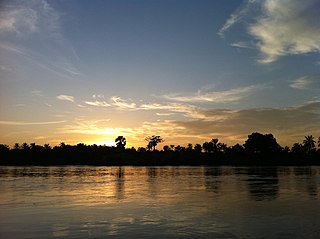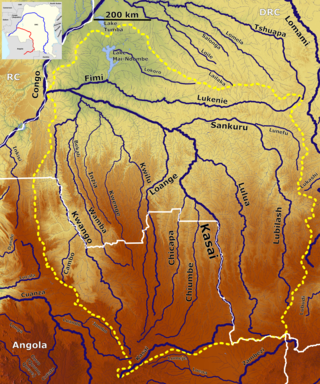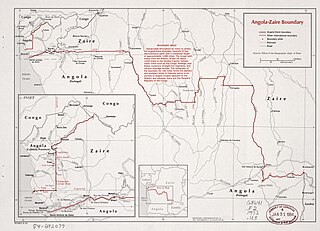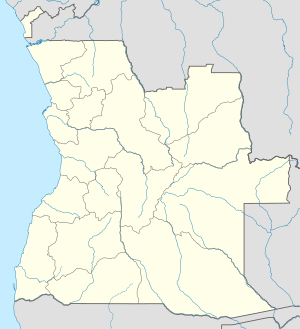
The culture of Angola is influenced by the Portuguese. Portugal occupied the coastal enclave Luanda, and later also Benguela, since the 16th/17th centuries, and expanded into the territory of what is now Angola in the 19th/20th centuries, ruling it until 1975. Both countries share prevailing cultural aspects: the Portuguese language and Roman Catholicism. However, present-day Angolan culture is mostly native Bantu, which was mixed with Portuguese culture. The diverse ethnic communities with their own cultural traits, traditions and native languages or dialects include the Ovimbundu, Ambundu, Bakongo, Chokwe, Avambo and other peoples.

Lunda Norte is a province of Angola. It has an area of 103,760 km² and a population of 862,566. Angola's first President, Agostinho Neto, made Lucapa the provincial capital after independence, but the capital was later moved to Dundo. The province borders the Democratic Republic of Congo in the northeast and Lunda Sul in the south. The province is rich in gold and diamonds, but remains vastly underdeveloped and impoverished. UNITA used the money generated from the sale of diamonds to fund war efforts. Cuango River valley, the richest diamond area of Angola is located in the province. Mining is done by notable companies like DeBeers and Endiama. The Lunda province whose capital was Saurimo was created by the Portuguese colonial empire on July 13, 1895. It was divided into Lunda-Sul and Lunda-Norte subdivisions through a constitution act in 1978 by the People's Movement for the Liberation of Angola (MPLA) government. Iron and manganese mining are also important economic activities. It is well known for its sculptures. The most notable one is The Thinker, a sculpture of a man holding his head. It is rich in terms of flora and fauna.

Lunda Sul is a province of Angola. It has an area of 77,637 km2 and a 2014 census population of 537,587. Saurimo is the provincial capital.

Malanje is a province of Angola. It has an area of 97,602 km2 and a 2014 census population of 986,363. Malanje is the provincial capital.

The Kasai River is a left bank tributary of the Congo River, located in Central Africa. The river begins in central Angola and flows to the east until it reaches the border between Angola and the Democratic Republic of the Congo, where it turns north and serves as the border until it flows into the DRC. From Ilebo, between the confluences with Lulua river and Sankuru river, the Kasai river turns to a westerly direction. The lower stretch of the river, from the confluence with Fimi river until it joins the Congo at Kwamouth northeast of Kinshasa, is also known as the Kwa(h) River.
Dundo, or Dundo-Chitato, is a former mining town, with a population of 177,604 (2014), now a city and the provincial capital of Lunda Norte in Angola. Established in the early part of the 20th century as a planned diamond mining community, Dundo has continued to grow, has its own airport and is now being superseded by a new city, New Dundo.

Endiama E.P. is the national diamond company of Angola and it is the exclusive concessionary of mining rights in the domain of diamonds. Angola's state-run diamond company Endiama produced 8.55 million carats of diamonds in 2010.
Cafunfo is a town, with a population of 90,000 (2014), in North-Eastern Angola dominated by the informal and formal diamond mining industries. The area has numerous alluvial diamond deposits.
The Jaga or Jagas were terms applied by the Portuguese to tribes such as Yaka, Suku, Teke, Luba, Kuba and Hungaan invading bands of African warriors east and south of the kingdom of Kongo. The use of the phrase took on different connotations depending on where it was applied. There were two groups of people, both known as fierce warriors, who were dubbed jagas or the jaga. Unbeknownst to the Portuguese who encountered these warriors, the two groups were practically unrelated.
Cuango, also Cuango-Luzamba or Luzamba, is a town and municipality in Lunda Norte Province in Angola. The municipality had a population of 183,767 in 2014. It is served by Luzamba Airport.
General Adriano Makevela Mackenzie is a prominent Angolan general in the Lunda Norte Province.
Kasongo Lunda is a territory in the Democratic Republic of Congo, located in Kwango Province. The capital lies at Kasongo Lunda. It is the second biggest territory in Congo, located near to the border with Angola.

The Cuango or Kwango is a transboundary river of Angola and Democratic Republic of Congo. It is the largest left bank tributary of the Kasai River in the Congo River basin. It flows through Malanje in Angola. The Kwango River basin has large resources of diamonds in the Chitamba-Lulo Kimberlite Cluster in Lunda Norte Province, discovered in the main river channel and on flats and terraces in its flood plains.

Kwango is a province of the Democratic Republic of the Congo. It's one of the 21 provinces created in the 2015 repartitioning. Kwango, Kwilu, and Mai-Ndombe provinces are the result of the dismemberment of the former Bandundu province. Kwango was formed from the Kwango district whose town of Kenge was made the provincial capital and thus gained city status.
Cuango-Luzamba Airport is an airport serving Cuango-Luzamba, in the Lunda Norte Province of Angola. The airport is known for its unrecovered wrecks.
Cambulo is a town and municipality in northeast Angola. The municipality had a population of 120,127 in 2014.

The Wamba River is a river in the Democratic Republic of the Congo (DRC) and Angola. It arises at an elevation of around 3,250 feet (990 m) as the confluence of several small streams in the Lunda Norte Province of Angola, a region of low hills and shallow ravines. In Angola it is known as the Uamba River.

The Angola–Democratic Republic of the Congo border is 2,646 km in length and consists of two non-contiguous sections: a 225 km section along the border with Angola's province of Cabinda, running from the Atlantic Ocean to the tripoint with the Republic of Congo, and a much longer 2,421 km section running from the Atlantic to the tripoint with Zambia.
Events in the year 2022 in Angola.

Os Kiezos is the name of a musical ensemble (conjunto) that emerged in 1963 in Marçal, a neighbourhood of Luanda. Known particularly within the genre of semba and Latin music like merengue, rumba and bolero. Os Kiezos are considered to be one of the most influential musical groups from Angola.











